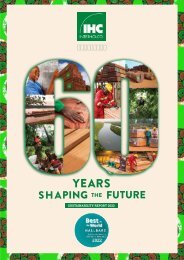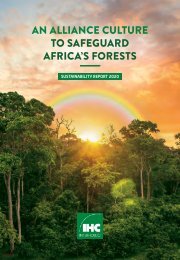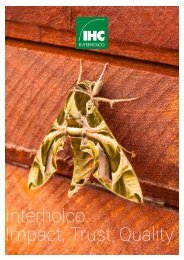Nomenclature Générale des Bois Tropicaux - 7ème édition
(english description below) Cette nomenclature est utilisée pour la mise à jour du 'Harmonized Code System' de l’Organisation Mondiale des Douanes. Dans la circulaire du 5 avril 2005, le Ministère de l’Economie, des Finances et de l’Industrie (France) reconnaît l’ATIBT comme « gardien du temple » de la nomenclature des bois tropicaux. La Commission Européenne mentionne la nomenclature de l’ATIBT comme document de référence pour la mise en œuvre du RBUE. Depuis 1954, l’ATIBT a établi et mis à jour une nomenclature des bois tropicaux faisant correspondre chaque espèce botanique avec un nom pilote reconnu internationalement. La détermination du nom pilote d’une essence est cruciale, car sa commercialisation dépend très largement de l’adoption de ce nom par le public. Le nom pilote assure la protection de l’appellation commerciale de l’essence et l’intégrité des propriétés qui lui sont attribuées, sans risque de confusion. The 1982 version of the general timber nomenclature has finally been updated as some of the 1,750 identified species, are no longer traded, while others, which were not previously included, are now on the market. The present revision has also integrated changes related to new taxonomy, in order to reflect the latest scientific developments. This Nomenclature has been used for the Harmonized Code System, updated by the World Customs Organization. The French Ministry of economy, finance and industry has given official recognition to ATIBT as the reference for the tropical timber nomenclature (NOR: PRMX0508285C of April 5th 2005). The European Commission refers to ATIBT nomenclature as a reference document for the implementation of the EUTR regulation. Since 1954, ATIBT has established and updated a nomenclature of tropical wood, linking each botanical species with an internationally recognized pilot name. A sigle wood species may have many common names; when trading across different countries, this may lead to confusion. Fixing the pilot name of a timber species is crucial, to protect the commercial denomination of the species and guarantee the veracity of the properties linked to that species, without confusion.
(english description below)
Cette nomenclature est utilisée pour la mise à jour du 'Harmonized Code System' de l’Organisation Mondiale des Douanes. Dans la circulaire du 5 avril 2005, le Ministère de l’Economie, des Finances et de l’Industrie (France) reconnaît l’ATIBT comme « gardien du temple » de la nomenclature des bois tropicaux. La Commission Européenne mentionne la nomenclature de l’ATIBT comme document de référence pour la mise en œuvre du RBUE.
Depuis 1954, l’ATIBT a établi et mis à jour une nomenclature des bois tropicaux faisant correspondre chaque espèce botanique avec un nom pilote reconnu internationalement. La détermination du nom pilote d’une essence est cruciale, car sa commercialisation dépend très largement de l’adoption de ce nom par le public. Le nom pilote assure la protection de l’appellation commerciale de l’essence et l’intégrité des propriétés qui lui sont attribuées, sans risque de confusion.
The 1982 version of the general timber nomenclature has finally been updated as some of the 1,750 identified species, are no longer traded, while others, which were not previously included, are now on the market. The present revision has also integrated changes related to new taxonomy, in order to reflect the latest scientific developments.
This Nomenclature has been used for the Harmonized Code System, updated by the World Customs Organization. The French Ministry of economy, finance and industry has given official recognition to ATIBT as the reference for the tropical timber nomenclature (NOR: PRMX0508285C of April 5th 2005). The European Commission refers to ATIBT nomenclature as a reference document for the implementation of the EUTR regulation.
Since 1954, ATIBT has established and updated a nomenclature of tropical wood, linking each botanical species with an internationally recognized pilot name. A sigle wood species may have many common names; when trading across different countries, this may lead to confusion. Fixing the pilot name of a timber species is crucial, to protect the commercial denomination of the species and guarantee the veracity of the properties linked to that species, without confusion.
You also want an ePaper? Increase the reach of your titles
YUMPU automatically turns print PDFs into web optimized ePapers that Google loves.
68 ///
Nomenclature générale des bois tropicaux 2016
PILOT NAME BOTANICAL NAMES COMMON NAMES
Kelumpang
Kembang Semangkok
Kempas
Keranji
Keruing
Keruntum
Kesiya Pine
Kiasose
Kibakoko
Kikenzi
Klinki
Kondroti
Kosipo
Sterculia foetida L.
Sterculia macrophylla Vent.
Sterculia shillinglawii F. Muell.
Sterculia spp. (AS)
Scaphium linearicarpum Pierre
Scaphium macropodum Beumee
Scaphium scaphigerum G. Planch.
Scaphium spp.
Koompassia malaccensis Maing.
Dialium cochinchinensis Pierre
Dialium indum L.
Dialium platysepalum Baker
Dialium spp. (AS)
Dipterocarpus acutangulus Vesque
Dipterocarpus alatus Roxb.
Dipterocarpus appendiculatus Scheff.
Dipterocarpus baudii Korth.
Dipterocarpus borneensis Slooten
Dipterocarpus caudatus Foxw.
Dipterocarpus costulatus Slooten
Dipterocarpus gracilis Blume
(Syn. Dipterocarpus pilosus)
Dipterocarpus grandiflorus Blco.
Dipterocarpus kerrii King
Dipterocarpus verrucosus Foxw
Dipterocarpus spp.
Combretocarpus rotundatus Danser
Pinus kesiya Royle
Pentadesma butyracea Sabine
Anthonotha fragrans Excell & Hillc.
Anthonotha macrophylla P. Beauv.
Anthonotha spp.
Ocotea usambarensis Engl.
Araucaria bidwillii Hook.
Araucaria cunninghamii Sweet
Araucaria hunsteinii K. Schum.
(Syn. Araucaria klinkii)
Araucaria spp.
Rhodognaphalon brevicuspe Roberty
(Syn. Bombax brevicuspe)
(Syn. Bombax chevalieri)
Rhodognaphalon schumannianum Robyns
(Syn. Bombax rhodognaphalon)
Entandrophragma candollei Harms
Kelumpang (MY) ; Perupak (MY) ; Po-Khanum
(TH) ; Rongga Jantan (MY) ; Trôm Hoa Nho (VN) ;
Trôm Maingay (VN)
Kembang Semangkok (MY) ; Samrong (TH) ; Selayar
(MY) ; Thitlaung (MM)
Impas (MY) ; Kempas (MY, PG) ; Menggeris (ID) ;
Mengris (MY) ; Toemaling (ID) ; Yuan (TH)
Kaki-Khao (TH) ; Keranji (ID, MY) ; Khleng (TH) ;
Kralanh (KH) ; Kuran (MY) ; Sepau (MY) ; Taung-
Kaye (MM) ; Xoay (VN) ; Yi-Thongbung (TH)
Apitong (PH) ; Chloeuteal (KH) ; Dau (VN) ; Gurjun
(IN) ; Hora (LK) ; Kanyin (MM) ; Keruing (ID) ;
Keruing Bajak (MY) ; Keruing Beras (MY) ; Keruing
Gaga (MY) ; Khlong (KH) ; Mai Nhang (LA) ; Mai
Sat (LA) ; Thbeng (KH) ; Tro (VN) ; Yang (MM,
TH)
Keruntum (MY) ; Perepat Darat (ID) ; Perepat Paya
(MY)
Khasya-Pine (IN) ; Saleng (PH) ; Son (TH) ; Sral
(KH) ; Thong (VN) ; Tinyu (MM) ; Tusam (ID)
Agnuhé (GA) ; Kiansonso (CD) ; Kiasose (CD) ; Kiasose
(CG) ; Lami (CI) ; N’Kandika (CG) ; Ouotélimo
(CI) ; Uouotera (CI)
Abara (NG) ; Andonmoteu (CI) ; Boleka (CD) ; Bonkotombolo
(CD) ; Bulimbusa (CD) ; Kibakoko (CD) ;
Kibakoko (CG) ; Mbombi (SL) ; Oghaba (NG)
Kikenzi (CD) ; Mkulo (TZ) ; Muura (KE) ; Muziti
(KE)
Bunya Pine (AU) ; Hoop Pine (AU) ; Irin Klinki Pine
(PG) ; Klinki (AU)
Alone (GA) ; Awori (NG) ; Bombax (GH) ; Kondroti
(CI) ; Kpatin Dehun (BJ) ; Meguza (MZ) ; Mfume
(TZ) ; Mungusa (MZ) ; N’Demo (CG) ; Ogumalanga
(GA) ; Ovong (CM)
Atom-Assie (CM) ; Bakanga (CF) ; Diamuni (CG) ;
Etom (GA) ; Heavy Sapele (NG) ; Impompo (CD) ;
Kosipo (CI, GH) ; Lifuco (AO) ; Omu (NG) ;
Penkwa-Akowaa (GH)














